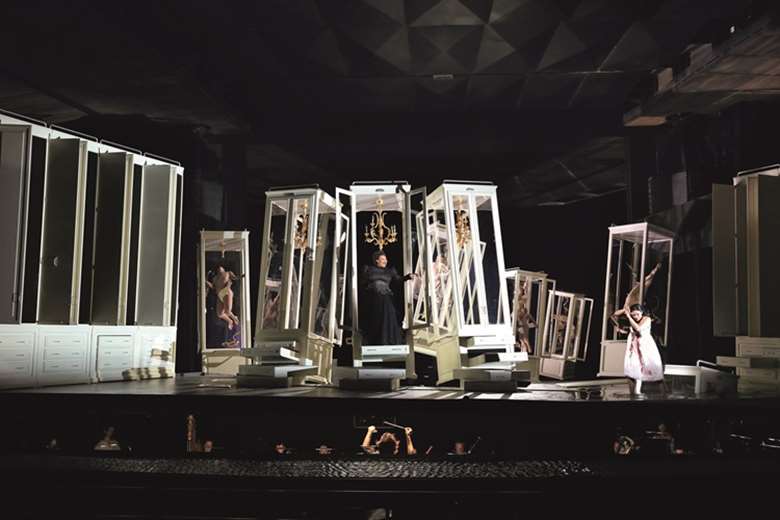Operatic innovation
Lidiya Yankovskaya
Monday, August 12, 2024
With funding for new work an ever-shrinking resource, conductor Lidiya Yankovskaya tailors her approach to the budget available and – along with her peers - makes the case for experimentation in opera

This article was originally published in our Summer 2024 issue. Click here to subscribe to our quarterly print magazine and be the first to read our Autumn issue features.
Every period of history is defined by its art. Through art we reflect – both for ourselves and for future generations – our priorities, passions, and achievements. The stagnation of operatic development puts us in danger of diluting – or losing – this invaluable form of artistic expression.
 ©Todd Rosenberg
©Todd Rosenberg
The current model is misguided, expecting composers to simply present a house with a completed work. We forget that Mozart, Verdi and Wagner each wrote a dozen operas unknown even to connoisseurs, but which formed part of the journey to the more familiar works we treasure. The canonic composers learned by doing, failing, and doing again. This is no longer the norm in opera, where creators rarely get the opportunity to change and experiment. As a result, the biggest innovators could be discarded before they truly begin.
"It’s such an extraordinary, alchemical thing, what the audience brings to the experience"
So, how should we support our creators? The most collaborative art form requires the most collaborative approach, and a robust development process is critical for fostering authentic works that resonate with today’s audiences. In recent years, workshops have become the norm in the US and Canada, where a golden age of new operatic work has taken root – despite the significantly larger number of opera institutions and resources in the UK and Europe. ‘The world is demanding more sophisticated theatrical experiences at the opera,' explains librettist Royce Vavrek. 'That requires us to do more heavy lifting in the construction of these pieces – more time, more resources.'
The structure and flow of the development process is essential. The way feedback is solicited, expressed, and interpreted, the order in which things are presented, the hierarchical patterns set up in the room – these details all matter. However, the most critical aspect of new opera development is that it serves the creators. A company must bring on trusted collaborators and let them lead the way, understanding that each has their own process and bearing in mind that a work in progress may not accurately reflect the final product.
Composer Joby Talbot agrees: ‘There is a seismic shift between sitting in a room by yourself and sitting in a room full of people experiencing the piece. When you hear it with someone else, it’s startling. It’s such an extraordinary, alchemical thing, what the audience brings to the experience. Having an opportunity to simply experience the performance with other people listening is invaluable.’
A thoughtful development process encourages experimentation and essential editing. Creating low-stakes opportunities during the writing process allows creators to hear the work in its true form and get a more complete sense of dramatic timing and architecture. Libretto readings, singer feedback sessions, experimentation with movement, piano and vocal workshops, regular work with dramaturgs, orchestral workshops, and preliminary public readings of the work all o er composers a chance to receive valuable informal feedback during the creative process.
"The world is demanding more sophisticated theatrical experiences at the opera. That requires us to do more heavy lifting in the construction of these pieces"
‘It’s easy for people to forget, especially if they’re not a creator, what that looks like,’ says composer Errollyn Wallen. ‘In a workshop, you investigate lines of inquiry. It’s for the leaders to really trust the creators – we are used to working with messes and things unanswered. It’s not a tidy process, but it’s so useful and necessary.’
But what about the bottom line? How does this ‘untidy’ process work when subjected to the confines of a budget? Creative partnerships – particularly between differently sized companies – can offer valuable opportunities for all organisations involved, while also building a following (and funding) around specific works. When a smaller company provides a workshop for a larger company’s premiere, the former benefits from the artistic association while the latter receives a stronger performance. Partnerships with educational institutions, orchestras and young artist programs leverage existing resources and provide training. Beyond the development itself, these collaborations promote visibility while cultivating connections and a wider range of perspectives.
Opera shows what it means for hundreds of people and every form of expression to come together and speak as one voice. But the artform can only thrive if we allow it to grow and change. I urge operatic institutions across the world to commit to cultivating opera’s next generation. Whatever the forum, the purpose of the development process is the same: to provide the artist with time, an opportunity to experience their work, and the chance to digest and then improve it, with supportive creative feedback along the way. Then do it again.
